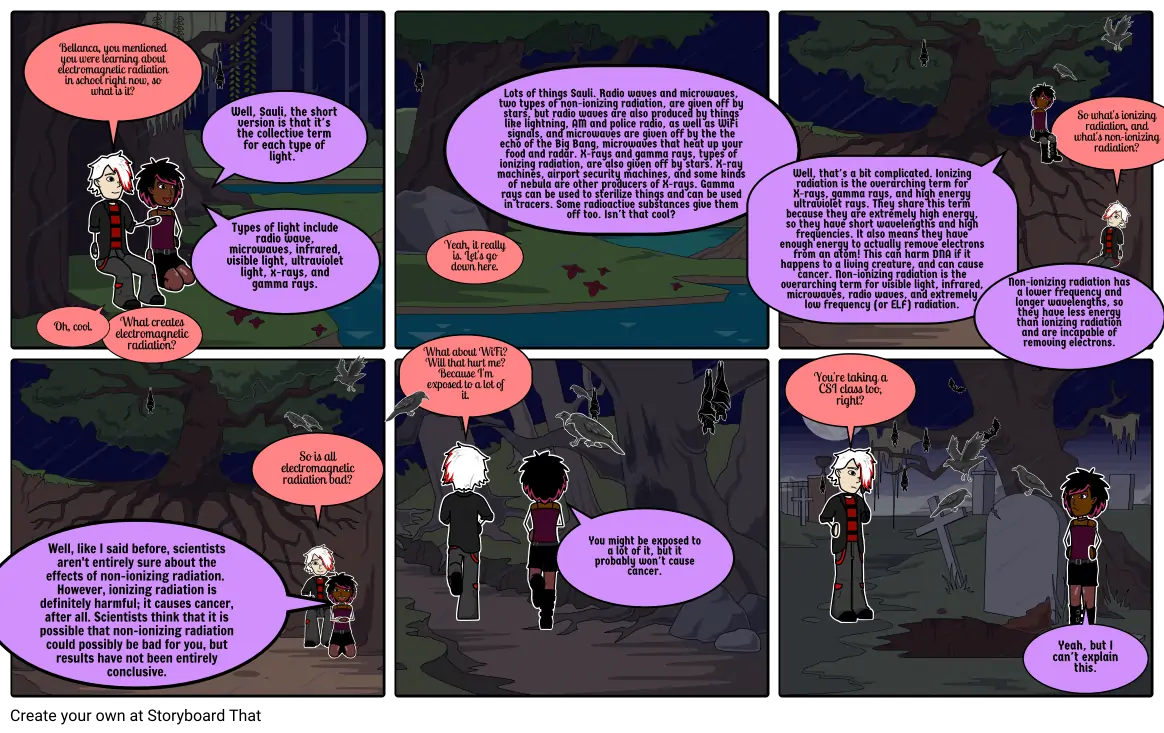Electromagnetic Radiation (and other quandaries) - Unit 2 PBL

Storyboard Description
The comic strip for my Unit 2 PBL project. Meant to describe sources of electromagnetic radiation, explain what makes electromagnetic radiation "benign" or "dangerous", and address public misconceptions about electromagnetic radiation.
Storyboard Text
- Bellanca, you mentioned you were learning about electromagnetic radiation in school right now, so what is it?
- Oh, cool.
- What creates electromagnetic radiation?
- Types of light include radio wave, microwaves, infrared, visible light, ultraviolet light, x-rays, and gamma rays.
- Well, Sauli, the short version is that it's the collective term for each type of light.
- What about WiFi? Will that hurt me? Because I'm exposed to a lot of it.
- Yeah, it really is. Let's go down here.
- Lots of things Sauli. Radio waves and microwaves, two types of non-ionizing radiation, are given off by stars, but radio waves are also produced by things like lightning, AM and police radio, as well as WiFi signals, and microwaves are given off by the the echo of the Big Bang, microwaves that heat up your food and radar. X-rays and gamma rays, types of ionizing radiation, are also given off by stars. X-ray machines, airport security machines, and some kinds of nebula are other producers of X-rays. Gamma rays can be used to sterilize things and can be used in tracers. Some radioactive substances give them off too. Isn't that cool?
- Well, that's a bit complicated. Ionizing radiation is the overarching term for X-rays, gamma rays, and high energy ultraviolet rays. They share this term because they are extremely high energy, so they have short wavelengths and high frequencies. It also means they have enough energy to actually remove electrons from an atom! This can harm DNA if it happens to a living creature, and can cause cancer. Non-ionizing radiation is the overarching term for visible light, infrared, microwaves, radio waves, and extremely low frequency (or ELF) radiation.
- Non-ionizing radiation has a lower frequency and longer wavelengths, so they have less energy than ionizing radiation and are incapable of removing electrons.
- So what's ionizing radiation, and what's non-ionizing radiation?
- So is all electromagnetic radiation bad?
- Well, like I said before, scientists aren't entirely sure about the effects of non-ionizing radiation. However, ionizing radiation is definitely harmful; it causes cancer, after all. Scientists think that it is possible that non-ionizing radiation could possibly be bad for you, but results have not been entirely conclusive.
- You might be exposed to a lot of it, but it probably won't cause cancer.
- You're taking a CSI class too, right?
- Yeah, but I can't explain this.
Over 30 Million Storyboards Created

